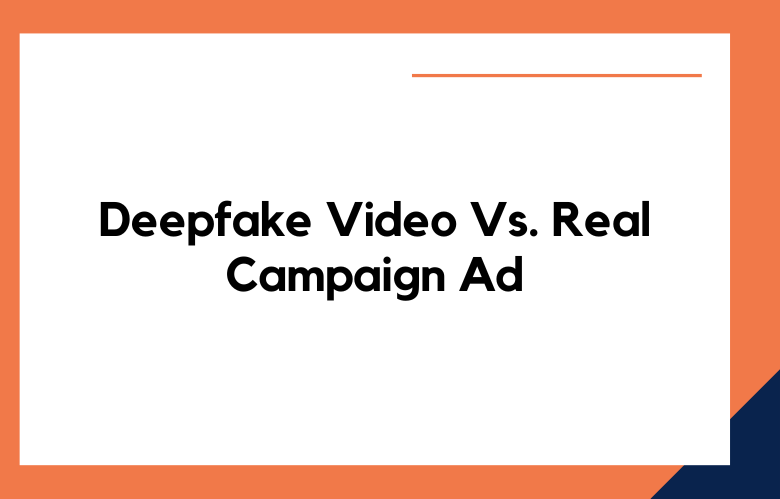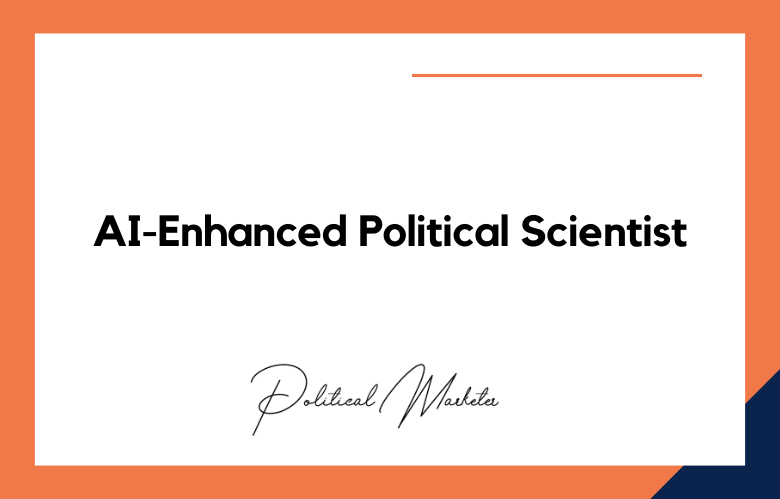While deepfake videos and real campaign ads may feature candidates or public figures, there are several key differences between the two: In today’s digital age, the lines between reality and manipulation are becoming increasingly blurred. This is especially true regarding political campaigns, where deepfake videos and real campaign ads compete for our attention and influence our opinions.
What is the Difference Between a Deepfake Video and a Real Campaign Ad?
In the age of digital media, it’s becoming increasingly difficult to distinguish between real and fake content, especially regarding political campaigns. Deepfake videos, which use advanced technology to generate or alter visual and audio content, have become a growing concern in the political arena, as they can be used to manipulate or deceive voters.
Authenticity
Deepfake videos are created using advanced technology to manipulate or generate visual and audio content, making it appear that the person in the video is saying or doing something they never did. On the other hand, real campaign ads feature genuine footage of the candidate or public figure, accurately representing their message and platform.
Intent
Deepfake videos are often created to deceive or manipulate viewers, spreading false information or damaging the reputation of the person featured in the video. On the other hand, real campaign ads are created to inform voters about the candidate or issue being promoted. They are subject to various regulations and standards to ensure accuracy and fairness.
Source
Deepfake videos may be created by anyone with the necessary technology and shared on various online platforms without verification or fact-checking. On the other hand, real campaign ads are typically created by the candidate or political party themselves or their authorized representatives. They are subject to fact-checking and other forms of scrutiny by the media and the public.
Impact
The impact of deepfake videos can be significant, as they can spread misinformation and undermine trust in democratic institutions. While they may not always be accurate or unbiased, real campaign ads are essential in informing voters and shaping public discourse more transparently and accountable.
Seeing is Deceiving: The Truth about Deepfake Campaign Ads
In today’s digital age, the line between reality and manipulation is increasingly blurred, and nowhere is this more evident than in political campaigns. With the rise of deepfake technology, it’s becoming harder to distinguish between authentic campaign ads and those deceptively altered to sway voters. So, what exactly is the Difference between a deepfake campaign ad and a real one?
A deepfake campaign ad is a political advertisement created using advanced technology to generate or alter visual and audio content, making it appear that a candidate said or did something they never did.
These ads can spread false information and manipulate voters based on false premises. On the other hand, an actual campaign ad is created by or on behalf of a political candidate or party and features genuine footage and information about the candidate’s platform, values, and goals.
Unmasking Deepfake: The Battle for Authenticity in Political Ads
The world of political advertising is no stranger to manipulation, but the emergence of deepfake technology has taken deception to a new level. Deepfake videos, which use advanced artificial intelligence to generate or alter visual and audio content, can create hyper-realistic imitations of real people, including political candidates. This poses a significant threat to the authenticity and integrity of political ads, as deepfake videos can be used to spread misinformation and sway public opinion.
The battle for authenticity in political ads is now more critical than ever. As deepfake technology becomes more sophisticated, it’s becoming increasingly difficult to distinguish between real and fake content. This seriously threatens democratic processes, as voters may make decisions based on false information.
Beyond the Illusion: Deepfake Vs. Real Campaign Videos
In the era of digital media, the line between reality and illusion is becoming increasingly blurred. The emergence of deepfake technology has made it easier than ever to create hyper-realistic imitations of real people, including political candidates. This raises important questions about the authenticity of political campaign videos and the potential for deception in our democratic processes.
At the heart of this issue is distinguishing between real and deepfake campaign videos. Deepfake videos are created using advanced AI algorithms that can generate or alter visual and audio content, making it challenging to identify the Difference between real and fake content. This poses a significant threat to the integrity of political campaigns, as deepfake videos can be used to spread misinformation and influence voter behavior.
From Fact to Fiction: Analyzing Deepfake Vs. Authentic Campaign Ads
The world of political campaigning has undergone a significant transformation in recent years with the advent of digital media and advanced technologies. However, with this transformation comes new challenges, particularly deepfake technology. Deepfake technology creates hyper-realistic imitations of real people, which can be used to generate fake campaign ads that are nearly indistinguishable from authentic ones.
In this article, we’ll analyze the differences between deepfake and authentic campaign ads, exploring the potential implications of this technology on the integrity of political campaigns. We’ll examine how deepfake technology can be used to manipulate and deceive voters, as well as the strategies that can be employed to combat its negative impacts.
The Rise of Deepfake Technology
Deepfake technology has advanced rapidly in recent years, allowing for the creation of highly realistic imitations of real people. This technology uses machine learning algorithms to analyze a person’s facial features and mannerisms. Then, it generates a synthetic version of that person that can be made to say and do anything.
While deepfake technology has a range of potential applications, from entertainment to education, it has also become a significant concern in political campaigning. With the ability to generate fake campaign ads that appear authentic, deepfake technology poses a serious threat to the integrity of democratic processes.
Distinguishing Deepfake from Authentic Campaign Ads
So, how can we distinguish between deepfake and authentic campaign ads? There are several key differences to look out for:
Authentic campaign ads typically feature genuine footage of the candidate, whereas deepfake ads use AI-generated footage.
Authentic campaign ads typically feature consistent facial expressions and mannerisms, whereas deepfake ads may have subtle inconsistencies.
Authentic campaign ads are usually created by the candidate or their authorized representatives, whereas deepfake ads may be made by anyone with access to the necessary technology.
Implications of Deepfake Technology
The implications of deepfake technology on political campaigning are significant. Fake campaign ads can spread misinformation, manipulate public opinion, and undermine the credibility of genuine candidates and campaigns. This can lead to a loss of trust in democratic institutions and a deterioration of the political discourse.
Strategies for Combating Deepfake Technology
To combat the negative impacts of deepfake technology, a multi-pronged approach is necessary:
Developing advanced AI algorithms to detect deepfake content and alert users to its presence
Implementing policies and regulations to ensure the authenticity of campaign materials and hold accountable those who create and disseminate fake ads
Promoting media literacy and critical thinking among voters so they can identify and discount fake ads
We are encouraging transparency and accountability among political candidates and campaigns, including disclosing the use of AI and other technologies in campaign materials.
An Uncanny Divide: The Differences Explored in Deepfake vs Genuine Political Ads
The rise of deepfake technology has added a new layer of complexity to the world of political advertising, creating an “uncanny divide” between actual and fabricated campaign messages. Deepfake videos, which use AI algorithms to generate or alter visual and audio content, can be challenging to distinguish from authentic campaign ads, raising concerns about the impact of misinformation on democratic processes.
One of the main differences between deepfake and genuine political ads is their authenticity. Simple campaign ads feature actual footage of candidates or public figures, accurately representing their message and platform. Deepfake videos, conversely, can falsely portray a candidate’s views or actions, potentially misleading voters and sway public opinion based on incorrect information.
Conclusion
Deepfake videos and real campaign ads differ significantly in authenticity, intent, source, and impact. Deepfake videos are manipulated or generated content that can spread misinformation and undermine trust in democratic institutions, while real campaign ads, although not always perfect, play an essential role in informing voters and facilitating open and accountable political discourse. It’s crucial to distinguish between the two and approach political content critically and discerningly.
Call: +91 9848321284
Email: [email protected]
What is the Difference Between a Deepfake Video and a Real Campaign Ad?: FAQs
What Is A Deepfake Video In Political Contexts?
A deepfake video is a synthetic or manipulated media file created using AI, often designed to make it appear that a political figure said or did something they did not.
How Is A Real Campaign Ad Different From A Deepfake?
A real campaign ad is created by or on behalf of a political candidate or party, with authentic footage and verified messaging, while deepfakes are often deceptive and not authorized.
What Technologies Are Used To Create Deepfakes?
Deepfakes manipulate video and audio using AI techniques such as deep learning, neural networks, and generative adversarial networks (GANs).
Can Deepfake Videos Be Detected Easily By Voters?
Not always. Many deepfakes are visually convincing, especially when viewed quickly or on mobile devices, making detection challenging for the average viewer.
Why Are Deepfakes Dangerous In Political Campaigns?
By presenting fabricated content as real, they can spread misinformation, damage reputations, mislead voters, and influence election outcomes.
How Can Voters Verify If A Video Is Real Or Manipulated?
They should check official campaign channels, look for inconsistencies in facial expressions or lip-syncing, and rely on reputable fact-checking organizations.
What Legal Protections Exist Against Deepfakes In Politics?
Some countries and jurisdictions have enacted laws criminalizing malicious use of deepfakes, particularly those meant to interfere with elections or defame individuals.
Are Real Campaign Ads Subject To Disclosure Rules?
Yes. Real campaign ads must usually disclose the sponsor and funding source and often comply with platform-specific political ad transparency rules.
How Can Political Campaigns Protect Themselves From Deepfakes?
By issuing rapid clarifications, watermarking in official videos, monitoring platforms, and leveraging AI tools to detect manipulated content.
Can AI Detect Deepfake Videos In Real Time?
Advanced AI tools can identify deepfakes using frame-by-frame analysis, inconsistencies in pixel patterns, or mismatched audio-visual cues.
Are Social Media Platforms Responsible For Removing Deepfakes?
Many platforms have community guidelines prohibiting manipulated media and offering takedown mechanisms when deepfakes violate policy.
Do Deepfakes Always Intend To Deceive?
Not necessarily. Some are created for satire, entertainment, or parody, but they become harmful when used in political contexts without disclosure.
How Can Journalists And Researchers Help Identify Deepfakes?
Using forensic tools, promoting media literacy, publishing alerts, and collaborating with platforms to analyze viral political content.
Is Audio Deepfaking A Concern Along With Video?
Yes. Audio deepfakes, which clone a speaker’s voice, are increasingly used in robocalls or fake speeches and can be just as misleading as video.
Can Deepfakes Violate Copyright Or Privacy Laws?
Yes. Using someone’s likeness or voice without consent can violate personality rights, copyright laws, and privacy protections.
What Role Does Media Literacy Play In Combating Deepfakes?
Educating the public to critically evaluate video content, verify sources, and recognize manipulation is essential to reducing the impact of deepfake videos.
How Can Political Leaders Respond To Deepfake Attacks?
They should respond quickly with verified content, alert platforms for takedown, and use legal, media, and technical teams to counter the spread.
Are There Tools Available To The Public To Detect Deepfakes?
Yes. Open-source tools and browser extensions can assist users in flagging suspicious media, although none are foolproof.
What Are The Ethical Implications Of Using Deepfakes In Politics?
Using deepfakes for manipulation undermines democratic processes, voter trust, and the integrity of political discourse.
Should Campaigns Publicly Disclose Use Of AI Or Synthetic Media?
Yes. Transparency builds trust and allows voters to make informed decisions about the authenticity and intent behind political messaging.











